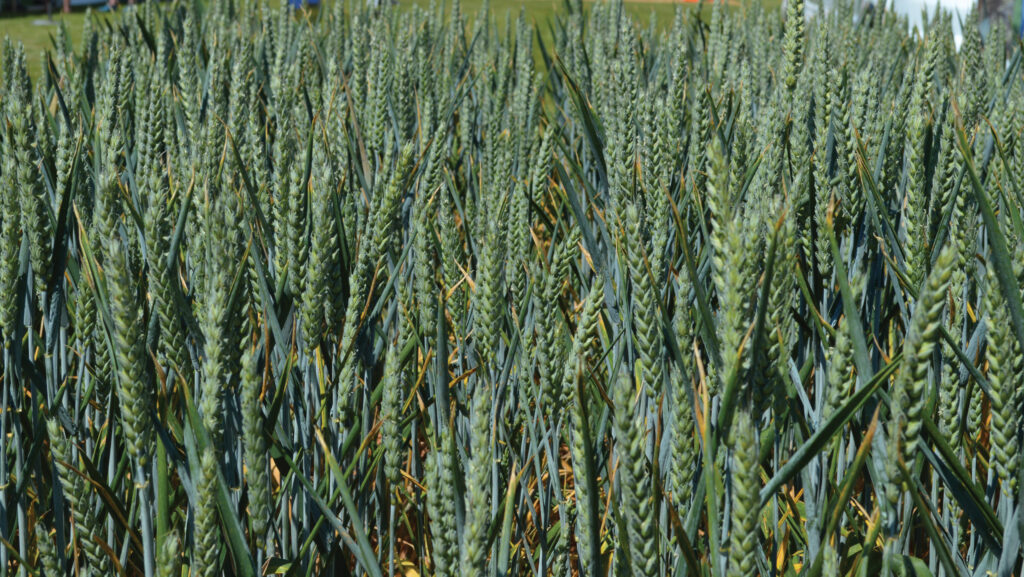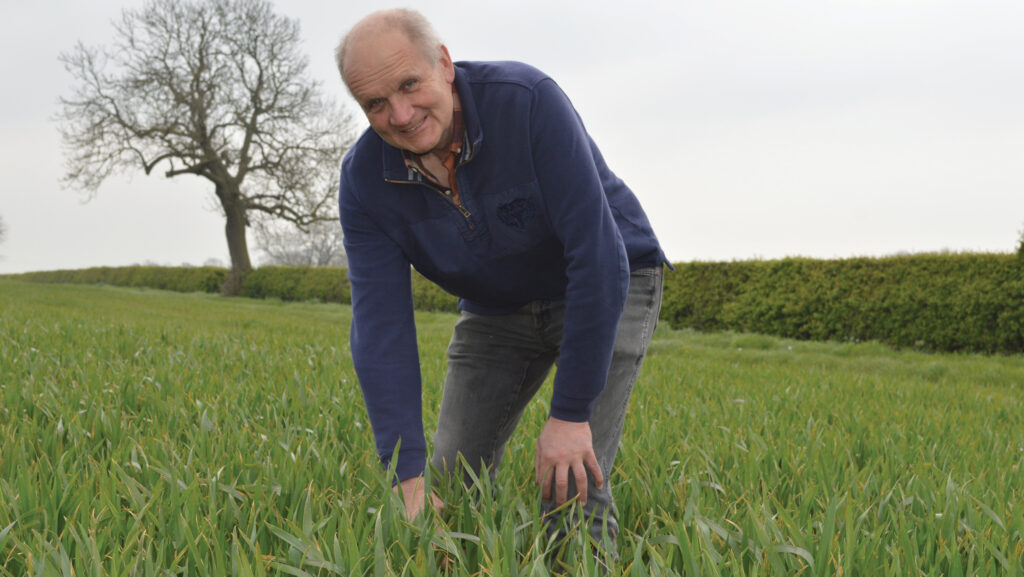North Yorks grower warms to feed winter wheat Beowulf
 © David Jones
© David Jones Peter Chapman is impressed with the new top-yielding feed winter wheat variety Beowulf on his farm, and he will grow it commercially if the yield of his current seed crop turns up trumps.
The Group 4 wheat has a strong septoria resistance score, very stiff straw and a high specific weight, and is tipped by the seed trade to sell well this coming autumn and be among the top six best-selling varieties.
Peter’s crop on his North Yorkshire farm beat other feed varieties Champion and Typhoon to the T1 spray stage, and the top leaves looked clear of septoria in early May after this fungicide spray had been applied.
See also: Tips to tackle foliar sugar beet disease in high risk season
Farm facts
P&J Chapman, Thornton Grange Farm, Thornton, Stainton, Middlesbrough
235ha of heavy clay arable land growing:
- winter wheat
- winter barley
- oilseed rape
- spring beans
Speaking on his 235ha all-arable Thornton Grange Farm, at Stainton, just south of Middlesbrough, he says:
“Champion was our top-yielding variety last year with 11-11.5t/ha, and we hope Beowulf will match it or exceed this yield in the coming harvest.”
The hard-milling feed variety from plant breeders Limagrain was one of the standout new entrants in the latest AHDB Recommended List (RL) announced at the end of last year, which placed it as equal top yielder along with Champion, Redwald and another newcomer, Bamford.
And it was the highest yielding variety overall in the North.
In untreated fungicide trials, it matched the yield of the most popular winter wheat variety Dawsum, and was only just behind the top overall untreated yielder Extase.
Seed traders say the only minor concerns about the variety are its slightly late maturity and only moderate brown rust resistance, but these are unlikely to dent its popularity.
It has the stiffest straw of the hard-milling Group 4s along with Cranium, both scoring 8s in a 1-9 AHDB RL rating system where 9 shows the characteristic to the greatest degree.
It is ahead of Dawsum and Typhoon on 7, Champion on 6.
Specific weight is a high 78.3kg/hl, well above the feed compounder industry standard of 72kg/hl, and just behind leading players Costello on 81.1kg/hl and Dawsum on 79.9kg/hl.

© David Jones
Main disease
Septoria is Peter’s main disease concern on his farm, and the variety has a strong score of 6.7, allied with a 9 for yellow rust, while only a modest 5 for brown rust.
Peter grows 150ha of winter wheat on heavy land with 24ha of Beowulf grown for seed and the rest including Champion, Extase, Dawsum, Palladium and Typhoon for commercial use with a focus on feed wheats, with his closest animal feed mill only three miles away.
When choosing varieties, Peter focuses on septoria and yellow rust resistance and standing power in addition to overall yield.
The variety also has orange wheat blossom midge resistance which might prove useful as he applies for environmental payments for non-insecticide use.
“Beowulf looks good so far and we will grow it commercially in the future as long as it yields and performs well,” he says
His 24ha of the variety followed oilseed rape, and after one pass of a Sumo Trio cultivator was sown on 17 September at a seed rate of 300 seeds/sq m with an Amazone Cirrus drill, followed by slug pellets and a post-emergence grassweed herbicide.
“The crop quickly established and by January and February it was standing out from the rest of the varieties,” he says.
As with all his wheats, the variety was hit by wet weather and cold north-easterly winds on his heavy clay land through the winter and into early spring.
Fungicides
All wheat varieties received a T0 cocktail in mid-April of another herbicide, the azole fungicide prothioconazole and plant growth regulator (PGR) chlormequat.
The application of a T1 spray was delayed by poor weather, and only started to go on from 1 May onwards and consisted of SDHI Vimoy (isoflucypram), azoles prothioconazole and tebuconazole, multisite protectant folpet and two PGRs trinexpac-ethyl, and chlormequat.
The T2 flag leaf spray was a robust fungicide mix, while a T3 ear wash spray will cover late foliar and ear diseases.
Nitrogen applications amount to 200kg/ha in three largely equal doses – the first in February of urea, while the second and third of ammonium nitrate went on in March and April.
Peter’s agronomist, Andrew Roy at advisory group Frontier, says the variety raced away and was fast developing, and so is probably not one for the early drilling slot, but generally the variety looks good.
“It looks a promising variety and we are feeling our way to where it fits. It looks like primarily a first wheat for sowing in the main drilling window,” he says.
Maturity
The variety is rated as +2 days in maturity terms, in line with Typhoon, Oxford and Costello and a little later than Dawsum on +1, Champion on 0 and Extase on -1, in a scale where Skyfall is a 0.
Despite its slight lateness, Peter does not see this as a problem as he likes a good spread of harvest dates for his winter wheats with limited staff on the farm, and he usually needs 10 days to get around the farm’s 150ha of wheat in the middle of August.
The moderate rating for brown rust resistance is also not seen as a particular concern on the farm, as temperatures are usually not warm enough for the disease to develop in North Yorkshire.
As the variety has midge resistance and as there is a limited threat from aphid-borne barley yellow dwarf virus he is planning to put 100ha of his wheat in the non-insecticide option of the Sustainable Farming Initiative to gain £45/ha, starting next season.
All-rounder
Clare Leaman, cereals variety specialist at crop consultant Niab, says the variety’s inclusion in the RL is a positive for wheat growers as it is a solid all-round variety.
“It looks a good variety and ticks all the boxes such as for yield, stiff straw, good specific weight and resistance to yellow rust and septoria,” she says.
Its slightly late maturity should not be a problem for most growers, and it will be interesting to see how this lateness is seen once it is grown widely on-farm, she adds.
Although there is more early brown rust around this season than usual, most growers can deal with this disease, as most fungicide regimes cover brown rust, while many other varieties have similar scores for brown rust such as Champion, Graham and Skyscraper.
Jim Knightbraid, seed business development manager at Frontier, says Beowulf is selling really well in the group’s early orders and is likely to be restricted only by limited seed.
“We are big fans of the variety. It look like it will fit in most situations as it is a well-rounded variety,” he says.
Jim adds there should be enough seed for 7% of the C2 commercial seed market this autumn, putting it in the top six best-sellers, and in autumn 2025 it should break into the current top three varieties – Dawsum, Extase and Champion.
Beowulf compared with other leading winter wheat varieties |
|||||
| Beowulf | Dawsum | Extase | Champion | Skyscraper | |
| Fungicide-treated yield (%) | 106 | 103 | 101 | 106 | 102 |
| Untreated yield (%) | 91 | 91 | 93 | 90 | 83 |
| Straw strength* | 8 | 7 | 7 | 6 | 6 |
| Specific weight (kg/hl) | 78.3 | 79.9 | 79.1 | 75.4 | 77.1 |
| Maturity (days +/- Skyfall |
+2 | +1 | -1 | 0 | 0 |
| Disease resistance | |||||
| Yellow rust* |
9 | 9 | 7 | 8 | 7 |
| Brown rust* | 5 | 7 | 6 | 5 | 5 |
| Septoria* | 6.7 | 6.3 | 7.4 | 7.9 | 4.9 |
| Orange wheat blossom midge | R | – | – | R | R |
| * On a scale of 1 to 9 with 9 showing the characteristic the most, R = Resistant | |||||

